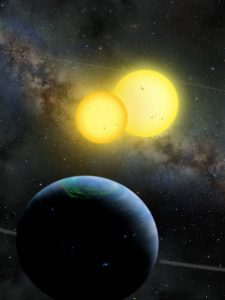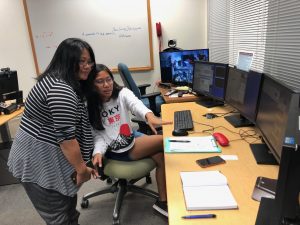Local Student Observes ‘Star Wars-Like’ Planetary System

An artist’s rendition of the Kepler-35 planetary system, in which a Saturn-size planet orbits a pair of stars. PC: Lynette Cook/extrasolar.spaceart.org.
In a galaxy far, far away, Luke Skywalker’s home planet of Tatooine had two suns. Now—in a galaxy much closer—a student recently observed a real-life planetary system that resembles the famed (but fabled) Tatooine system.
Laura Daclison, a senior at Waipahu High School and Maunakea Scholars Program participant, caught an up-close look at a two-star (or circumbinary) system called Kepler-35.
A rare phenomena, circumbinaries are essentially real-life versions of the two-starred planetary system seen in Star Wars Episode IV: A New Hope. Daclison wanted to help astronomers gain a better understanding of them.
“I chose Kepler-35 because the two stars are really similar to our sun,” said Daclison. “I thought, if Earth had two suns just like Kepler-35, maybe there would be some correlation between them.”
After applying to the Maunakea Scholars Program in February, her proposal was selected for further study.

Waipahu High School Senior Laura Daclison shows her mom, Lisa, how she used the Keck I telescope to study Kepler-35 at Keck Observatory’s Remote Operations room in Waimea, Hawai‘i. Courtesy photo.
“This is definitely science that you would expect to come from a professional astronomer,” said Keck Observatory Support Astronomer Josh Walawender. “In fact, once Laura had showed me her proposal, I got her in touch with some professional astronomers who were doing very similar work on slightly different types of stars. And Laura actually got them to look at a slightly different type of object than they might have otherwise. She did great!”
Daclison was guided and mentored by Walawender, Canada-France-Hawai‘i-Telescope Outreach Program Manager Mary Beth Laychak, University of Hawai‘i Institute for Astronomy (UH IfA) graduate students Christian Flores and Anna Payne, and UH IfA postdoc Lauren Weiss.
She conducted her observations over a period of one hour on the night of Nov. 19, capturing a slice of night sky using the HIRES (High-Resolution Echelle Spectrometer) instrument installed at W.M. Keck Observatory.
Daclison is only the second high school student to observe at Keck Observatory since the telescope became operational 25 years ago. Unlike Luke Skywalker, who became “the last Jedi,” she will not be the last of the Maunakea Scholars.













